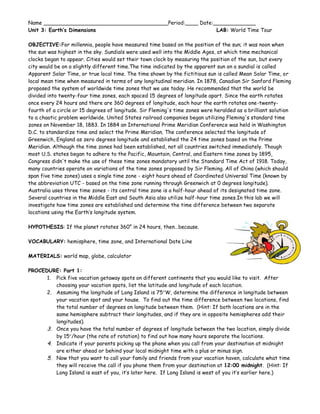
Lab time zones -
- 1. Name ______________________________________Period:____ Date:_____________<br />Unit 3: Earth’s Dimensions LAB: World Time Tour<br />OBJECTIVE: For millennia, people have measured time based on the position of the sun; it was noon when the sun was highest in the sky. Sundials were used well into the Middle Ages, at which time mechanical clocks began to appear. Cities would set their town clock by measuring the position of the sun, but every city would be on a slightly different time. The time indicated by the apparent sun on a sundial is called Apparent Solar Time, or true local time. The time shown by the fictitious sun is called Mean Solar Time, or local mean time when measured in terms of any longitudinal meridian. In 1878, Canadian Sir Sanford Fleming proposed the system of worldwide time zones that we use today. He recommended that the world be divided into twenty-four time zones, each spaced 15 degrees of longitude apart. Since the earth rotates once every 24 hours and there are 360 degrees of longitude, each hour the earth rotates one-twenty-fourth of a circle or 15 degrees of longitude. Sir Fleming's time zones were heralded as a brilliant solution to a chaotic problem worldwide. United States railroad companies began utilizing Fleming's standard time zones on November 18, 1883. In 1884 an International Prime Meridian Conference was held in Washington D.C. to standardize time and select the Prime Meridian. The conference selected the longitude of Greenwich, England as zero degrees longitude and established the 24 time zones based on the Prime Meridian. Although the time zones had been established, not all countries switched immediately. Though most U.S. states began to adhere to the Pacific, Mountain, Central, and Eastern time zones by 1895, Congress didn't make the use of these time zones mandatory until the Standard Time Act of 1918. Today, many countries operate on variations of the time zones proposed by Sir Fleming. All of China (which should span five time zones) uses a single time zone - eight hours ahead of Coordinated Universal Time (known by the abbreviation UTC - based on the time zone running through Greenwich at 0 degrees longitude). Australia uses three time zones - its central time zone is a half-hour ahead of its designated time zone. Several countries in the Middle East and South Asia also utilize half-hour time zones. In this lab we will investigate how time zones are established and determine the time difference between two separate locations using the Earth’s longitude system.<br />4800600114935<br />HYPOTHESIS: If the planet rotates 360° in 24 hours, then…because.<br />VOCABULARY: hemisphere, time zone, and International Date Line<br />MATERIALS: world map, globe, calculator<br />PROCEDURE: Part 1:<br />Pick five vacation getaway spots on different continents that you would like to visit. After choosing your vacation spots, list the latitude and longitude of each location. <br />Assuming the longitude of Long Island is 75W, determine the difference in longitude between your vacation spot and your house. To find out the time difference between two locations, find the total number of degrees on longitude between them. (Hint: If both locations are in the same hemisphere subtract their longitudes, and if they are in opposite hemispheres add their longitudes).<br />Once you have the total number of degrees of longitude between the two location, simply divide by 15/hour (the rate of rotation) to find out how many hours separate the locations. <br />Indicate if your parents picking up the phone when you call from your destination at midnight are either ahead or behind your local midnight time with a plus or minus sign.<br />Now that you want to call your family and friends from your vacation haven, calculate what time they will receive the call if you phone them from your destination at 12:00 midnight. (Hint: If Long Island is east of you, it’s later here. If Long Island is west of you it’s earlier here.)<br />PROCEDURE: Part 2:<br />Complete Pinwheel Activity Sheet<br />DATA:<br /> Continent City, Country Latitude () Longitude () Long Island Longitude 75W 75W 75W 75W 75W Difference in Longitude () Time DifferenceFrom Long Island (+/- hours) Time at your house (am / pm)<br /> <br />QUESTIONS:<br />How many time zones exist on Earth? Why? ____________________________________<br />What is jet lag? ________________________________________________________<br />How could you leave to go fishing on Tuesday, actually do your fishing on the prior Monday, and return home back on Tuesday when you left? ______________________________________________________________________________________________________________________________________________<br />Arrange the following cities in order of whom would celebrate the New Year first: Tehran, Iran; Los Angeles, USA; Beijing, China; Rio de Janeiro, Brazil; Sydney, Australia; Cape Town, South Africa; Shanghai, China. Provide an explanation why? _____________________________<br />_____________________________________________________________________<br />CONCLUSION: Explain how time zones were established, include local noon in your answer!<br />_______________________________________________________________________________<br />4686300102235________________________________________________________________________________<br />ABOVE & BEYOND: Explain how and why some locations on our <br />planet have time zones that are different from their neighboring areas, <br />including to the half of an hour! ____________________________________________________________________________________<br />______________________________________________________<br />